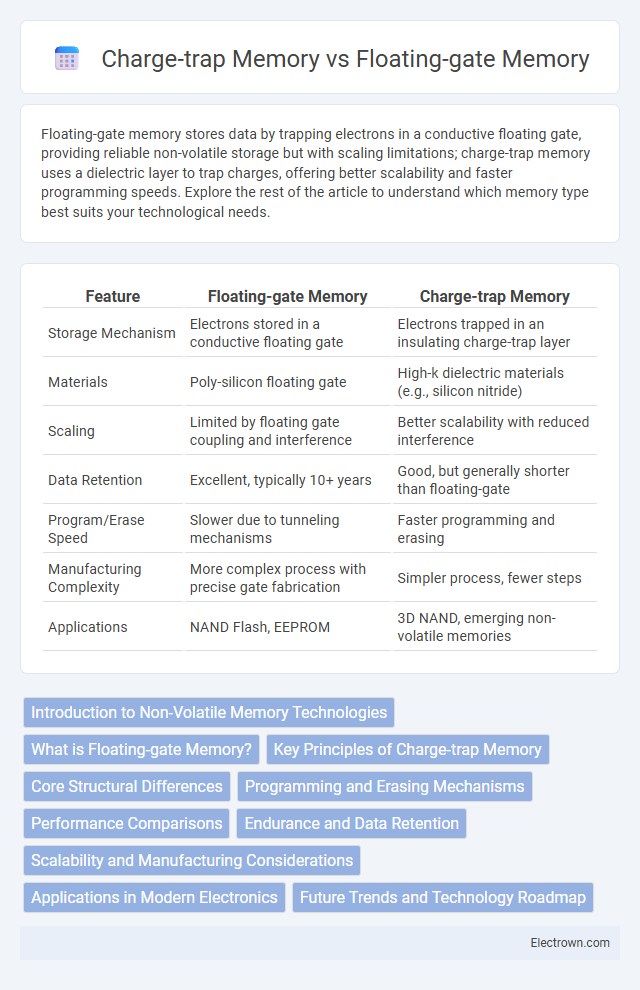Floating-gate memory stores data by trapping electrons in a conductive floating gate, providing reliable non-volatile storage but with scaling limitations; charge-trap memory uses a dielectric layer to trap charges, offering better scalability and faster programming speeds. Explore the rest of the article to understand which memory type best suits your technological needs.
Table of Comparison
| Feature | Floating-gate Memory | Charge-trap Memory |
|---|---|---|
| Storage Mechanism | Electrons stored in a conductive floating gate | Electrons trapped in an insulating charge-trap layer |
| Materials | Poly-silicon floating gate | High-k dielectric materials (e.g., silicon nitride) |
| Scaling | Limited by floating gate coupling and interference | Better scalability with reduced interference |
| Data Retention | Excellent, typically 10+ years | Good, but generally shorter than floating-gate |
| Program/Erase Speed | Slower due to tunneling mechanisms | Faster programming and erasing |
| Manufacturing Complexity | More complex process with precise gate fabrication | Simpler process, fewer steps |
| Applications | NAND Flash, EEPROM | 3D NAND, emerging non-volatile memories |
Introduction to Non-Volatile Memory Technologies
Non-volatile memory technologies such as Floating-gate Memory and Charge-trap Memory store data without power by trapping electrical charge in insulating layers. Floating-gate Memory uses a conductive floating gate embedded in the transistor's oxide layer to retain charge, enabling high endurance and fast programming speeds. Charge-trap Memory relies on localized charge storage within silicon nitride or high-k dielectric layers, offering better scalability and reduced interference in advanced semiconductor nodes.
What is Floating-gate Memory?
Floating-gate memory is a type of non-volatile memory that stores charge on a conductive floating gate isolated by an insulating oxide layer, enabling data retention without power. This architecture allows for reliable electron trapping, making it the foundation of widely used flash memory technologies like NOR and NAND flash. Its ability to maintain stored information by controlling charge tunneling through oxide layers distinguishes it from alternative memory types such as charge-trap memory.
Key Principles of Charge-trap Memory
Charge-trap memory stores data by trapping electrons in an insulating layer, typically silicon nitride, which alters the threshold voltage of the transistor, enabling efficient non-volatile storage. Unlike floating-gate memory that uses a conductive floating gate to hold charge, charge-trap memory benefits from better scalability and lower interference due to its discrete charge storage nodes. Understanding these key principles helps you appreciate how charge-trap memory supports higher density and improved reliability in modern flash technologies.
Core Structural Differences
Floating-gate memory features a conductive floating gate layer completely surrounded by an insulating oxide, allowing charge storage within a metal or polysilicon gate. Charge-trap memory uses a non-conductive charge-trapping layer, typically silicon nitride, to localize charge without a floating gate. The insulating materials and charge confinement methods define their distinct core structural differences, influencing programming speed, retention, and endurance.
Programming and Erasing Mechanisms
Floating-gate memory programs by injecting electrons into a conductive floating gate through hot-electron injection or tunneling, enabling charge storage that represents data, while erasing occurs by removing electrons via Fowler-Nordheim tunneling. Charge-trap memory stores charge in a localized trap layer within the dielectric using similar injection methods, but erasing typically employs a different tunneling process that targets the trapped charges. Your choice between these technologies affects programming speed, endurance, and retention due to the distinct mechanisms governing charge storage and removal.
Performance Comparisons
Floating-gate memory offers faster write speeds and higher endurance, making it suitable for applications requiring frequent data updates, while charge-trap memory excels in scalability and lower power consumption, enhancing efficiency in compact semiconductor devices. The charge-trap structure reduces electron leakage, improving data retention time compared to floating-gate memory, which is prone to charge loss over extended periods. Performance in terms of programming voltage favors charge-trap memory, as it operates at lower voltages, reducing stress on insulating layers and extending device lifespan.
Endurance and Data Retention
Floating-gate memory offers superior endurance with the ability to endure millions of program/erase cycles, making it highly reliable for long-term use. Charge-trap memory provides improved data retention at elevated temperatures due to its intrinsic charge-trapping layer, which reduces leakage. Understanding these differences can help you select the optimal memory type for applications requiring specific durability and retention characteristics.
Scalability and Manufacturing Considerations
Floating-gate memory faces scalability challenges due to increased interference and tunneling difficulties as device dimensions shrink below 20 nm. Charge-trap memory offers superior scalability with simpler fabrication processes, utilizing insulator layers that reduce leakage and allow for smaller cell sizes. Your choice between these technologies impacts manufacturing costs and yields, with charge-trap memory generally providing advantages in advanced node integration and process variability control.
Applications in Modern Electronics
Floating-gate memory is widely used in non-volatile storage solutions such as solid-state drives (SSDs), USB flash drives, and embedded systems due to its high density and proven reliability. Charge-trap memory offers advantages in scaling and endurance, making it suitable for emerging applications in mobile devices, IoT sensors, and advanced NAND flash technologies. Both memory types play critical roles in modern electronics by enhancing data retention, power efficiency, and device miniaturization.
Future Trends and Technology Roadmap
Floating-gate memory technology faces scaling challenges due to charge leakage and interference at smaller nodes, prompting a shift towards charge-trap memory which offers better scalability and reliability in advanced semiconductor processes. Future trends emphasize 3D integration and multi-level cell (MLC) architectures to boost storage density and speed, with charge-trap memory poised to dominate emerging non-volatile memory applications like embedded flash and neuromorphic computing. Your choice between these technologies should consider long-term roadmap factors such as endurance, retention, and compatibility with next-generation device fabrication techniques.
Floating-gate Memory vs Charge-trap Memory Infographic

 electrown.com
electrown.com